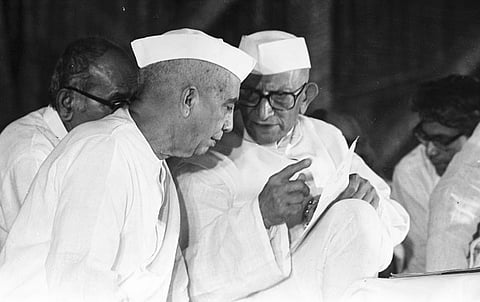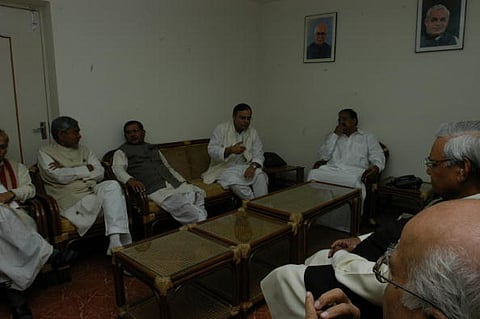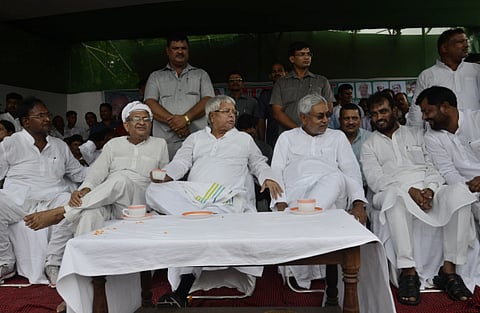Within hours of Bihar Chief Minister Nitish Kumar jumping the boat for the fourth time in a decade to form a government again with his traditional ally Bharatiya Janata Party (BJP), the electoral strategist and former Janata Dal-United (JD-U) leader Prashant Kishore said, “The BJP is doing now what the Congress had done during RJD supremo Lalu Prasad’s time. Both national parties have aligned with hugely unpopular regional leaders for small gains at the central level.”
Anti-Congressism To Mandal-Kamandal: India’s Tryst With Coalition Politics
The journey of coalition politics in India shows an ideological vacuum that hangs over the fate of any possible alliance.
This statement of Kishor —who earlier worked as the electoral consultant of both Modi and Kumar— if read in today’s political context may give a sense of contemporary power struggle among the central and regional parties. But if it is decoded historically, it points at the biggest casualty of coalition politics: ideology.
The recent crisis in the INDIA bloc following a trail of events —Nitish’s exit, Mamata Banerjee and Bhagwant Mann’s decision to go alone, Akhilesh Yadav’s unilateral declaration of 11 seats for Congress in Uttar Pradesh where the grand old party is seeking at least 20 out of 80 seats to name a few— made it anything but an ideological alternative. However, this is nothing new in the history of Indian coalition politics. Though, crossing the fence for power was not as much apparent as is seen in the case of Nitish; ideology has always taken a backseat in coalition politics.
Anti-Congressism Sowing Seeds Of Coalition Politics
Notably, India’s coalition politics mostly went through three stages. The first one can be called anti-Congressism or non-Congressism. In 1963, socialist leader Ram Manohar Lohia for the first time propounded this idea. He thought that the Congress party’s thumping victory in three consecutive general elections engendered a belief among the people that the party had become invincible. He wanted all the opposition parties to put their respective weights behind one candidate so that the anti-Congress votes are not divided.
The idea of Lohia materialised in the 1967 elections when the grand old party was defeated in seven states and the Samyuktha Vidhayak Dal government was formed by the opposition parties. Political analyst Shriram Yerankar writes that Lohia actually sowed the seeds of coalition politics in India.
Lohia’s understanding of political expediencies was echoed by some senior Congress leaders as well. Maharashtra-based senior Congress leader and freedom fighter S K Patil, while referring to the necessity of coalition politics in 1969, said, “Now, it is obvious that the process of coalitions must start and coalitions must be formed not only after but also during and before the elections. If well-planned coalitions are formed before the election, they will develop a capacity of lasting longer and becoming more effective in actual functioning.”
In a prophetic manner, Patil, whose political acumen was rarely questioned, added, “Coalitions have become a political necessity in India today. It will take a long time, not less than 25 years, to develop a two-party system in India.”
However, anti-Congressism of Lohia culminated in the 1977 elections when the Janata government —a coalition of four parties having different hues and colours— dethroned Indira Gandhi and established the first non-Congress government at the central level. Though this government couldn’t survive due to an internal power struggle and Morarji Desai had to tender his resignation within two years, it marked the beginning of a coalition future and so of anti-Congressism.
Mandal/Kamandal-Social Justice As Ground For Coalition
The next 10 years in Indian politics, however, witnessed a certain shift in politics. It was no more anti-Congressism only. It was peppered with the ideology of social justice — a concept that outlived many other ideological struggles in India. All of this, however, began with the formation of V P Singh’s national front government in 1989. Though Congress was the largest party in the parliament, they preferred to not form the government as a ‘political strategy’, thinks scholars.
Consequently, Singh’s government became a rainbow alliance where he was backed by left, right, and center. On one hand, he had Congress; on the other, he had CPI, CPI (M), the RSP and the Forward Bloc. On top of it, he got the support of the BJP which was withdrawn later citing Lal Krishna Advani’s arrest by Lalu Prasad Yadav in October 1990, leading to the fall of his government.

However, during this short-lived government, he recommended the implementation of the Mandal Commission report, opening the floodgate of controversy and the fight over Mandal/Kamandal. The social justice parties along with the left started aligning with any party that at least promised to stand firmly against the Kamandal/Hindutva politics. But the foundational angst against the Congress was there. When Chandra Shekhar tendered his resignation in 1991, dissolving his short-lived government, the then President R Venkataraman said, “During his few months in office, he had handled parliament completely and responsive to suggestions from the opposition. He was under constant strain from the pressures of the Congress party, which I am afraid, assumed that it was the real government and Chandra Shekhar only a proxy.”
Targeting his salvo at the Congress party, he added, “The office-hungry coterie of the Congress party used to misguide Rajiv Gandhi that Chandra Shekhar’s attempts at building up a good image could prove deleterious to his image... I realised that unequal combinations are always disadvantageous to the weaker side.” The former president’s realisation of the disadvantage of the weaker side within the coalition was echoed in the consecutive falls of the Deve Gowda and I K Gujral governments.
Gowda’s United Front government —a coalition of 13 parties including Samajwadi Party, DMK, Asom Gana Parishad, Tamil Manila Congress, CPI, and the Telugu Desam Party besides the outside support from Congress— was truly, as political analyst B K Sharma calls it, “a chariot pulled by 13 horses in 13 directions”. Still, the major player was the Congress and when they pulled the string over some alleged miscommunications, the government fell. The Gujral government also faced a similar fate in 1998.
But these four-five years were the only time when the non-BJP, non-Congress social justice and left parties had a formidable voice in shaping the political context of the country. It was the time when the West Bengal Chief Minister and one of the tallest leaders of the left front, Jyoti Basu, was invited to take charge as PM but his party declined. Basu later in an interview called it a “historic blunder”.

However, the impact of anti-communal politics strengthened by the social justice parties was so strong that the Janata Dal was split over the senior leadership’s decision to join the first BJP-led National Democratic Alliance (NDA) government in 1999. Deve Gowda opposed Sharad Yadav and founded Janata Dal (Secular) emphasising his distance from the communalised politics.
Shift To Winnability?
The anti-Congressism and Mandal/Kamandal plank if determined the fate of coalition politics till the formation of NDA, the next two decades witnessed the winnability coalition. Parties like Trinamool Congress (TMC) and JD (U) started shifting sides depending on their necessity. Mamata Banerjee’s TMC while started its journey as a constituent of NDA; in post-2008 scenario when their arch-rival left front withdrew support from the UPA I citing their opposition to the nuclear deal, they immediately jumped the boat and found a friend in Congress — the party she deserted to make her own party.

However, this relationship didn’t survive long. Though TMC gained the fruits of its alliance with Congress in both the 2009 general elections and the 2011 state assembly elections, by 2016, Banerjee preferred to walk alone. And recently in the context of the INDIA bloc, she had further made it clear that her party would offer no more than two seats to Congress, spoiling the prospect of any probable seat-sharing talks.
The TMC is just one of the many instances in today’s coalition politics where the foundational aspiration to build up an alliance lies in numbers, not ideology. The failure of the INDIA bloc could be attributed to such an ideological gap in coalition-building.
Besides, there is continuous apprehension that Congress does not intend to cede the space to junior regional partners. The journey of India’s coalition politics thus shows an ideological vacuum that hangs over the fate of any possible alliance. And in this backdrop, the comments of Kishore again become relevant, reminding how the ‘political gains’ determine solidarity, not ideological conviction.